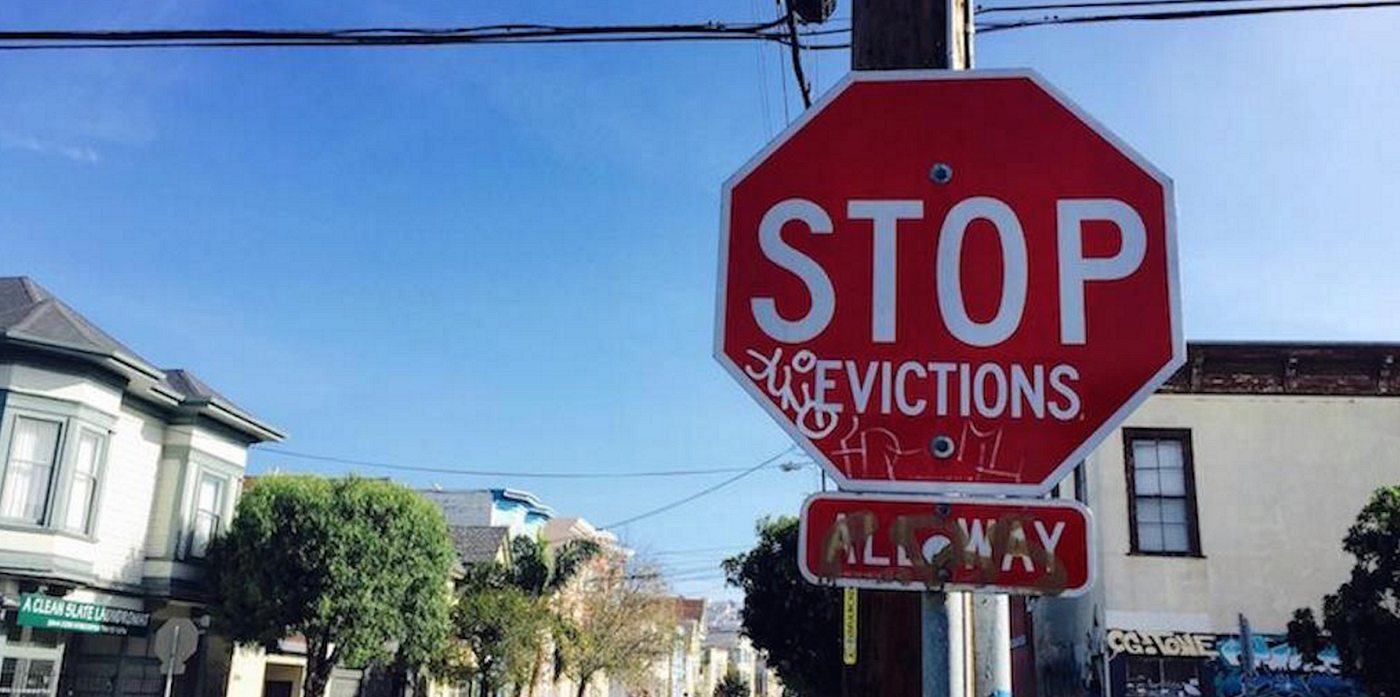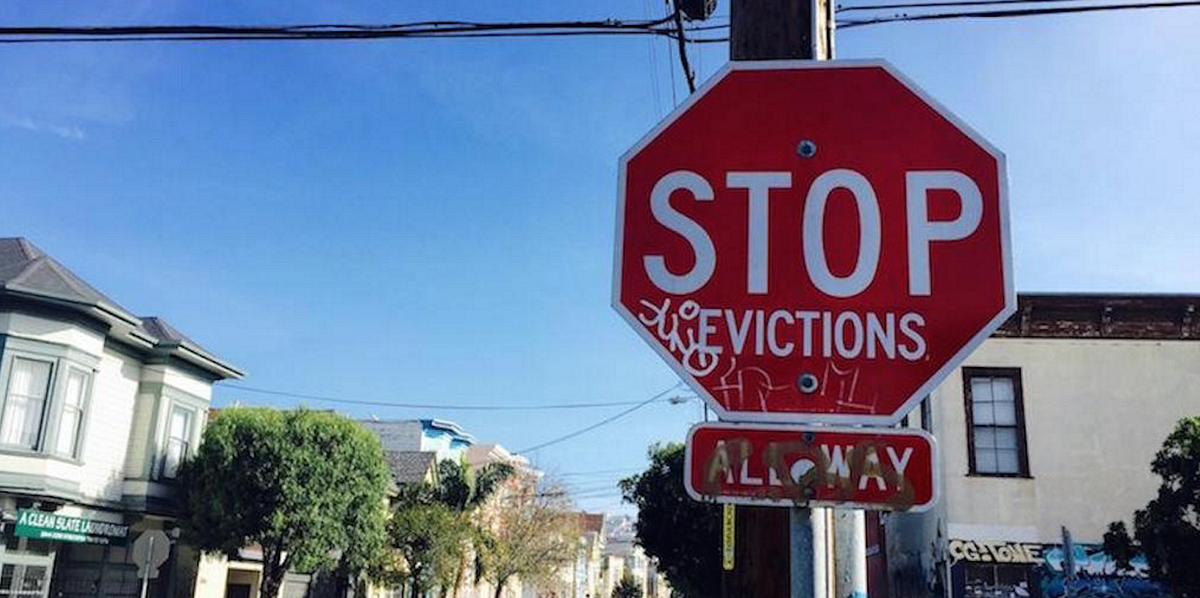
You hear about evictions and displacement all the time in San Francisco. In fact, it’s one of the most dominant international news stories about our foggy city: the real estate “explosion,” the housing crisis, the Googlization of San Francisco — or whatever you want to call it.
As the real estate and rental markets continue to go crazy, San Francisco has been undergoing huge demographic shifts. Right now it’s in the middle of a great whitening, and I’m not talking about cosmetic dentistry. Our city is the “only Bay Area county where ethnic and racial diversity will actually decrease,” according to a USC study. Likewise, we seem to have hit a new normal of permanently rising rental and home prices, to the effect that the median single-family home price is now way more than one million.
So that leads to another question: are more people getting displaced and evicted now than ever before, or — given that we’ve been in a bullish real estate market for decades — is it about the same? It’s true that evictions often occur for non-scummy-landlord reasons; sometimes renters just trash a place or turn it into a meth lab.
I looked at how evictions varied over the past 15 years in San Francisco to gain some insight into what’s really going on. Here are the takeaways.
1. Over 8,500 tenants received eviction notices during the past five years.
This first stat is a doozy: 8,619 tenants officially received eviction notices from 2010 to 2015. Remember how the city has a population of about 900,000? Accounting for migration, that means that around 1% of the city was served eviction notices (remember, more than one person lives in most units).
2. To break it down more, eviction notices went up by 50%, from 1,400 in fiscal year 2010–2011 to 2,100 in 2014–2015.
This is a 50% increase in five years or, in other words, about 10% higher year to year, as the data trends up every year from 2010 to 2015. This doesn’t bode well, and it’s predicted that 2015 will have registered 2,700 evictions once the dust has settled.
Here’s a terrifying thought experiment: if eviction notices continue to increase by 10% per year, how long until everyone — all 900,000 of us — are evicted? The answer is 2078. Let’s hope that by then we’ve all uploaded our consciousnesses into a computer, rendering us unevictable.
3. Eviction notices go up and down with the housing market.
This is the most damning piece of evidence that shows that landlords scheme to evict people when they know they can profit the most. Since San Francisco is always at full capacity, the increase or decrease in evictions year to year should be about the same, provided that the demographics stay the same.
To give some context: evictions in 2006–2007 numbered 1,450, while in 2007–2008 they hit 1,650. Then there was a drop that correlated with the Great Recession, and evictions dipped to a 15-year low of 1,250 in 2009–2010 before beginning the trend of the 10% annual rise mentioned above. This strongly suggests that landlords do their darndest to evict when they know they can either sell for big bucks or rent to wealthier tenants.
4. Evictions due to “breach of lease” rose the fastest from 2012 to 2015.
When I was in the 10th grade, a sheriff came to speak to our driver’s-ed class. At the time, the law said you could not be pulled over for not wearing a seatbelt, but if you were pulled over for something else, the cop could then ding you for not wearing one. On this matter, the deputy said to the class, “Technically, we can’t pull you over just for not wearing a seatbelt. But if we see you’re not wearing one, trust me, we can find a reason to pull you over.”
It seems that landlords follow a similar logic, which could be summed up as follows: “We can’t evict you for no reason whatsoever, but if we want to evict you, trust us, we’ll find a reason.” Likewise, it’s unlikely that in the period of 2012–2015 — when evictions due to breach of lease nearly doubled, from 468 to 738 — we were hit with an epidemic of hooligan San Franciscan renters graffitiing kitchens, throwing ragers and doing things that broke their leases. More likely, the rising housing and rental market was too tempting for some landlords, and they studied the situation until they could figure out how they could bend the rules to evict their tenants.
5. Ellis Act evictions went way down for a few months when landlords were threatened by communities organizing against evictions.
Though it wasn’t the law’s original intent, the Ellis Act is a state statute that has been wrangled by landowners to mean “we can evict everyone in the building unconditionally and then renovate and rent it to new people for more money.” Interestingly, when the Ellis Act was drafted, its intent was actually to stop unscrupulous landlords from wronging evicted tenants by providing compensation to low-income tenants who were evicted when landlords went under. Now, with the Ellis Act, they have to change what the function of the building is in order to evict — even if that change is superficial, such as changing it from rental apartments to condos.
Ellis Act evictions shot up between June 2011 and February 2014, from 50 a month to over 400. What happened in February 2014? That was when community organizers and activists started blowing the whistle, putting pressure on city council to do something. Then Proposition G, a proposed tax on speculation, went on the ballot, and landlords and big developers got scared.
Hence, Ellis Act evictions plummeted to February 2011 levels, in the sub-50 range, and remained there until — and here’s the kicker — immediately after the November 2014 election, when Proposition G was defeated. They’ve been rising steadily since; by April 2015, they’d peaked at 250 again.
The moral here? Activism and community organizing work. Obviously, it helps to win at the ballot box, but in the short term, simply the fear of tenants fighting back was enough to scare landlords away from using the Ellis Act to flip rentals.
Photo courtesy of Audrey Dilling.







